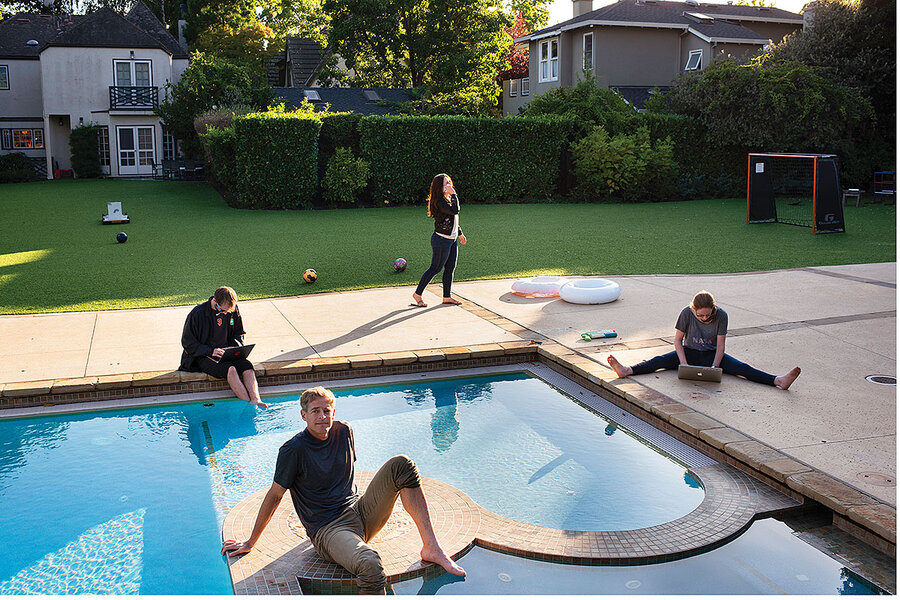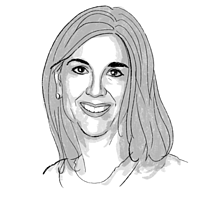Mary Beth Meehan’s photos dissolve distances between people
Loading...
Silicon Valley conjures images of high-tech millionaires living like modern-day kings. The reality, as photographer Mary Beth Meehan depicts in the book “Seeing Silicon Valley: Life Inside a Fraying America,” is strikingly different.
“The dominant narrative about a ‘utopia’ obscures how life is actually lived, and what it means to be a human being there,” Meehan says.
Why We Wrote This
From afar, the lives of others can take on a caricature-like quality. Mary Beth Meehan’s photography invites neighbors to see each other more fully.
Silicon Valley is a microcosm of the broader inequality that divides the nation, according to Meehan. The effects are felt not just economically but socially. “People are living right next to each other and they don’t interact,” she says.
To counter this separation, the photographer created portraits that encourage viewers to go beyond stereotypes to see the people who make up this amorphous place known as Silicon Valley. The result is a book of images that speaks to the human toll exacted by the relentless economy.
This latest effort follows a series of Meehan’s community portrait projects in Massachusetts, Georgia, and Rhode Island. “I’m interested in all the ways that we see each other incorrectly, and how photography can push against that,” she says.
Silicon Valley exerts a magnetism like a tractor beam on people from around the world. They come to the San Francisco Bay Area seeking riches, or at least the trickle down from the booming high-tech economy led by Apple, Alphabet (owner of Google), and Facebook.
The reality, as photographer Mary Beth Meehan depicts in the book “Seeing Silicon Valley: Life Inside a Fraying America,” is strikingly different. Yes, tech companies have created thousands of jobs, she says in an interview, “but the dominant narrative about a ‘utopia’ obscures how life is actually lived, and what it means to be a human being there.” The gap between the ultra-wealthy and ordinary workers – who cannot afford housing and basic necessities even with decent-paying jobs – is widening.
Silicon Valley is a microcosm of the broader inequality that divides the nation, according to Meehan. The effects are felt not just economically but socially. “People are living right next to each other and they don’t interact,” she says. To counter this sense of separation, the photographer created portraits that encourage readers to go beyond stereotypes to see the people who make up this amorphous place known as Silicon Valley. The result is a book of images that speaks to the human toll exacted by the relentless economy.
Why We Wrote This
From afar, the lives of others can take on a caricature-like quality. Mary Beth Meehan’s photography invites neighbors to see each other more fully.
The project began with an invitation from Stanford University professor Fred Turner, who brought Meehan to the university with the idea of using photography to go beneath the “streets of gold” myth. Her photographs would help answer questions such as: Who lives in the area? What are the conditions in which they live?
It’s not the first time that Meehan has created portraits of individuals in a specific community; her past projects include Brockton, Massachusetts; Newnan, Georgia; and her now-hometown of Providence, Rhode Island. The process she developed in those cities set the template for her work in Silicon Valley. In each of those projects, she spent time getting to know the area. She went out with her camera and knocked on doors, visited houses of worship, and talked with people on the street and in their homes.
Meehan’s approach involves capturing people from a cross section of a city’s demographics. “Each individual is her- or himself, but they also represent a community, a whole ecosystem,” she says. Some of her photographs of Newnan and Providence eventually became large-scale banners, the biggest measuring 38 feet wide, that were displayed on public buildings in those cities, furthering dialogues within the communities.
Meehan, who grew up in a working-class family with immigrant Irish and Italian roots, has made it her lifework to help spark conversations among people of different racial, class, and cultural backgrounds. The essence of her approach is simple but far from easy: “Just go talk to people.”
She’s aware that her background as a well-educated white woman might raise questions in some communities that have been historically misunderstood and misrepresented in the media. “I’m interested in all the ways that we see each other incorrectly, and how photography can push against that,” she says.
The people in these neighborhoods are far more accustomed to journalists and researchers who have already formed a judgment about the situation before they even ask their first question. Meehan takes a different approach: “Let’s let the people, who are the experts on their own lives, tell us.”
Meehan has wrestled with photography’s history as a tool of exploitation, in which people with money and access have had the power to shape the dominant narrative. She’s come to the conclusion that the practice of photography needs to be rebuilt in a way that “doesn’t reinscribe the old ruptures.” The answer, she says, is developing deeper collaborations. For her, this means mentoring everyone from schoolchildren to older adults from diverse backgrounds as they find their own paths to self-
expression through photography.
When she makes portraits, Meehan collaborates with individuals to decide where and how they will be photographed, and what they’ll be wearing. Her skill is seen in the deliberateness with which she frames and edits the picture.
By highlighting the humanity of each person, Meehan hopes to bring out the viewer’s humanity. This is especially important in a place like Silicon Valley, she says, where the wealthy may not really see the people who clean, cook, and care for them and their families. It’s a place where immigrants arrive seeking the American dream, only to end up struggling to find a foothold.
“Each project is pushing against a big system,” she says. “In Silicon Valley, it’s the myth that the economy there is floating all boats.” Why, she argues, can’t some of that enormous wealth go into creating healthy lives for the people there? “That’s the question we’re really asking, and what does that say about the American economy?”













